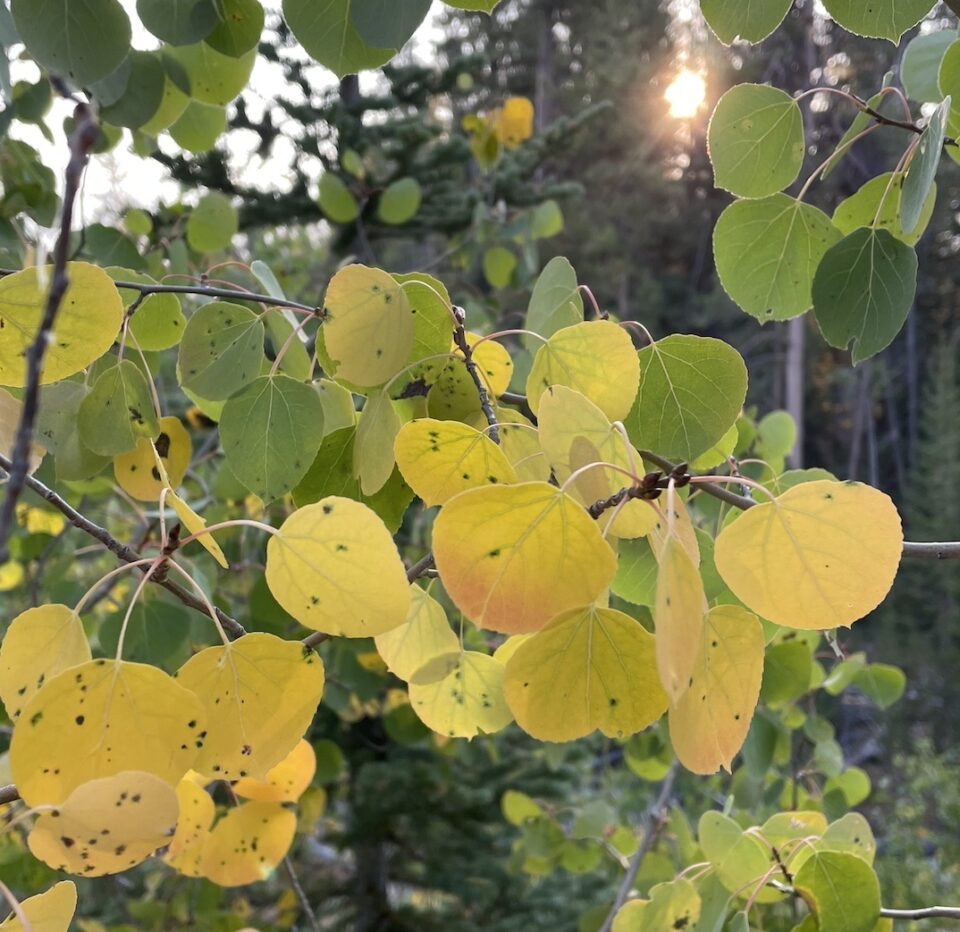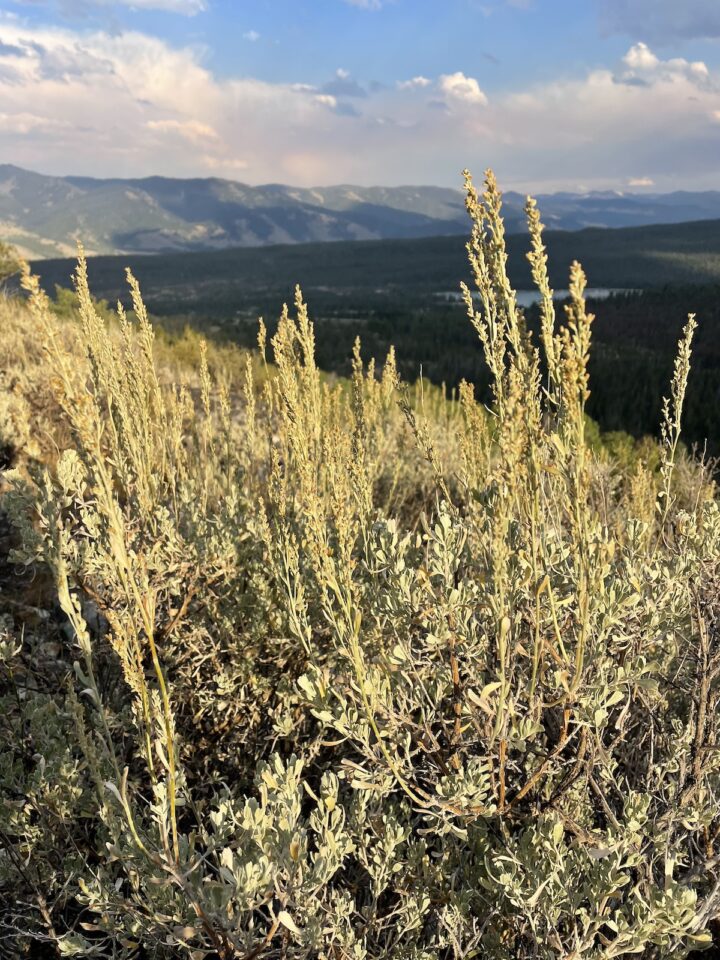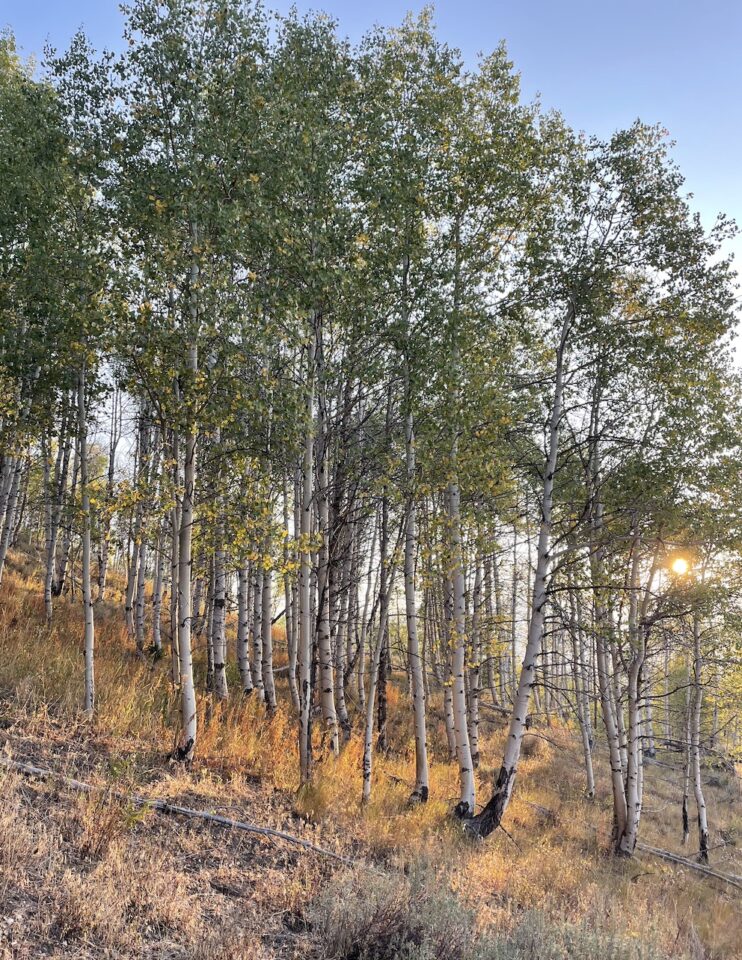
As night temperatures have dropped, the aspen have started to change from green to gold and orange. Photo credit: SIHA staff
A few weeks ago, before the smoke from the Wapiti Fire descended, I started to notice some subtle changes in the land around me. The squirrels were becoming more active in their pursuit of those lodgepole cones up in the treetops, the birds were starting to flock up, and there was a little more gold than green in the grasses and aspens. I also started having a feeling of nostalgia or longing, mixed with excitement or anticipation.
Did you feel it too? That’s Zugunruhe!
Ok, ok, not exactly by the strict scientific use of the word, but the definition captures what I think of with that inner shift from season to season. (Plus it’s fun to say!)
Zugunruhe (zu-gən-ru′) is a German word that means an inner stirring or restlessness to move. It is specifically used in science to refer to migratory restlessness in birds and was first noted in publication in 1707 by German ornithologist, Gustav Kramer. Kramer observed that birds in captivity became more agitated and restless at certain times of the year, before migrations in the wild would typically start. Further studies over time have shown the same.
While mammals, including humans, don’t really experience Zugunruhe – an instinctual impulse to move based on resource availability, we do seem to experience some sort of inner restlessness or stirring when the seasons begin to turn. A better word for what we mammals experience could be “seasonality.” This is where a behavior change, like the elk rut, or physiological change, like snowshoe hare coats turning from brown to white in the winter, occurs because of changes in daylight length, temperatures, or other seasonal cues.
Due to our separation from nature through consistent lighting and temperature of our indoor spaces, modern humans don’t have a lot of seasonality change, other than maybe swapping swimsuits for puffies in the stores, or picking up a pumpkin spice latte instead of vanilla. However, if you can tune in and get outdoors a bit more on these seasonal cusps you may find that you actually can see and feel some of the change coming on.

The sagebrush flowers, one of our late summer blooms, have started to fade. Photo credit: SIHA staff
For myself, the shift from summer to fall usually starts about a month before the seasonal transition really becomes apparent. I can never quite put my finger on what tips my internal clock when this happens each year, but suddenly it’s there – a bittersweet type feeling or longing, mixed with excitement and restlessness. Is it the shortening days, drop in nighttime temperatures, or the shifting colors and fading flowers that clue me in? As an artist and naturalist, I’m fairly in tune with the seasonal patterns of the flora and fauna around me, but again, often I get the feeling before I visually identify the physical world is changing. Most likely it is a combination of cues that we experience to create this sense that summer is giving way to fall, with winter only a few weeks behind.

Grasses are drying and dropping seeds as the sun shifts, day by day, further south. Photo credit: SIHA staff
If you haven’t identified or experienced this feeling yourself, here are a few things you can do now (or at any time of seasonal shift) to start to become more aware.
You could set up a temporary routine of walking in a certain location over the course of the next week or two. Observe the color of the plants, the stages of seedheads and flowers, the temperature, and time of sunrise or sunset. Smell the air and try to focus on how it feels against your skin. Bring a notebook, or a camera, and document what you’re seeing and experiencing. Over those days, you may discover subtle changes that you typically don’t notice happening right before your eyes!
You could consider starting a phenology calendar. Phenology is the study of timing and patterns in natural world, including life cycles of plants or animals or when weather events occur, such as the first snowfall. There are pre-made calendars online or you can simply start by writing the date and your nature observations in a notebook, such as noticing birds are flocking up, that the grass is starting to turn yellow, or that there was frost on the ground. Over the years you will be able to see patterns, or unusual occurrences, in seasonal timing!
Whatever you decide to do, and whether you are paying attention closely or not, zugunruhe, seasonality, and the endless flow of nature cycles is happening around us every day. For us, here in the Sawtooths, fall is definitely tip-toeing in. Can you feel it?
Alicia is a naturalist and the 2024 Program Coordinator for SIHA. When not at the Redfish Visitor Center, you’ll find her hiking, making art, taking pictures, and swimming in all the beautiful lakes of the Sawtooths with her husband, Jeff.